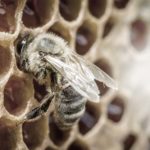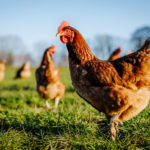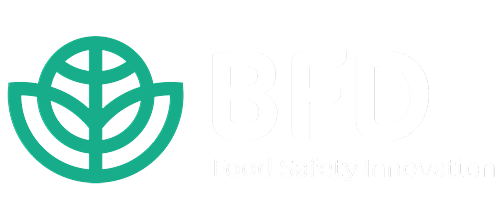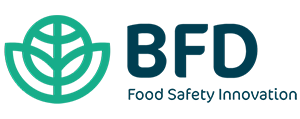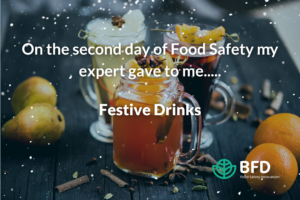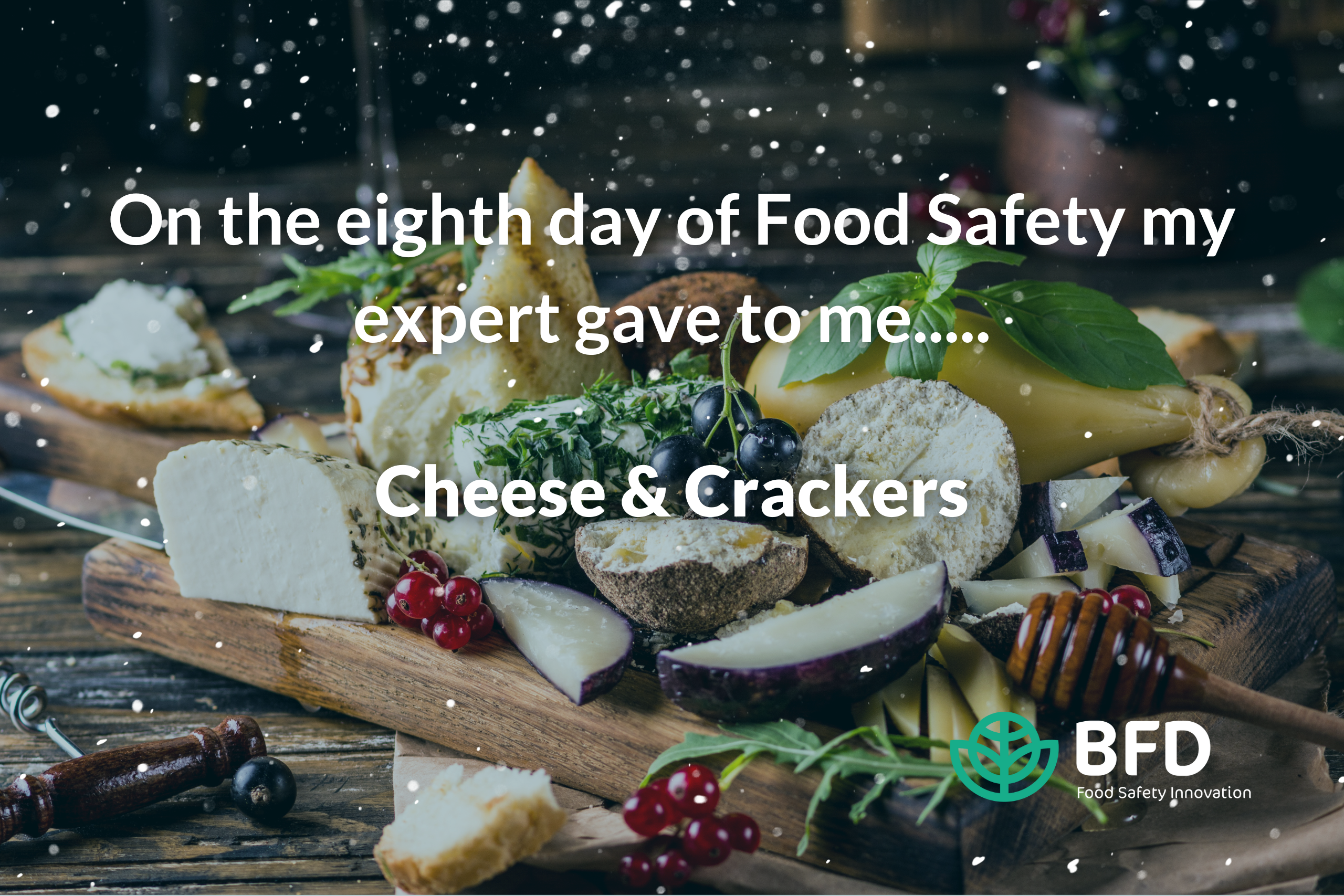
Cheese and Crackers: Day 8 – 12 Days of Food Safety
Day 8: Cheese & Crackers
12 Days of Food Safety
There are countless cheeses globally, each with its own unique production methods and characteristics such as texture and flavour. During the holiday season, cheese boards are a popular choice for festive gatherings. The selection for these boards often includes a mix of classic and specialty cheeses served with a wide array of crackers and breads.
Below are examples of a few cheeses from around the world that you may find present on your table this season.
Cheddar: is one of the most popular and widely produced cheeses in the world. It originated in England but is now produced globally. The aging process determines the flavour profile, with younger cheddars being milder and mature ones having a sharper taste.
Brie: is a soft, creamy cheese named after the French region from which it originated. It is known for its edible white rind and buttery texture. Brie is often enjoyed with fruits or crackers.
Blue Cheese: are characterized by the distinctive blue or green veins of mould running through them. The mould is intentionally introduced during production, contributing to the cheese’s strong flavour.
Feta: Feta is a crumbly, tangy cheese that originated in Greece. It is traditionally made from sheep’s milk or a blend of sheep’s and goat’s milk. Feta is commonly used in salads and Mediterranean cuisine.
Ricotta: Ricotta is an Italian whey cheese made from the leftover whey after the production of other cheeses. It has a mild, slightly sweet flavour and is commonly used in both sweet and savoury dishes.
How is cheese made?
Although a number of variables during production can contribute to the diversity of the cheese, the initial stages of cheese-making always begins with the careful selection of high-quality milk from sources such as cows, goats, and sheep. Generally after this step the milk then undergoes coagulation with starter cultures and enzymes, which forms curds that are cut, heated, and moulded into specific shapes. Pressing then expels any remaining whey, and salt is added for flavour, preservation, and moisture control. The cheeses then enter an aging phase, developing unique flavours and textures. After reaching maturity, the cheese is then packaged for distribution, ready to delight with individual characteristics, from the crumbly texture of feta to the creamy richness of brie.
What testing is carried out?
Cheese undergoes multiple food safety tests, and one of the most common includes crucial examinations for antibiotics in the milk used for production. Regulatory bodies, such as the U.S. Food and Drug Administration (FDA) and the European Food Safety Authority (EFSA), have established limits for antibiotic residues in food products and therefore testing for these antibiotics in milk is a critical aspect of quality control in the dairy industry. The testing process typically involves several stages to detect and quantify the presence of antibiotics. First, upon milk collection, initial screening tests are conducted to identify potential antibiotic residues. Rigorous testing continues at other various steps such as tanker arrival, plant processing, bulk tanker and finished production stages. This helps to prevent contaminated milk from entering the food supply chain, ensuring that consumers receive safe and high-quality dairy products. In some cases, retailers or quality control organizations may also conduct independent testing on the final products at retail level before they reach the consumer. This adds an extra layer of assurance regarding the absence of antibiotic residues. These tests aim to meet regulatory standards and detect even trace amounts of antibiotics, as their presence in milk can pose health risks and contribute to antibiotic resistance.
Key Players in the Dairy industry
As consumer awareness in food production practices continue to rise, numerous dairy producers pride themselves on their careful sourcing and production methods, highlighting the steps taken to guarantee the quality and safety of their products before entering the food chain. Testing transparency allows for consumers to make informed choices, ensuring that the dairy products they select meet the highest standards.
Some key players that have a significant global presence in the dairy industry that implements rigorous quality control and testing procedures for its dairy products by adhering to industry standards and regulations to ensure the safety, quality, and compliance of their products.
Fonterra Cooperative Group (New Zealand): Fonterra is one of the world’s largest dairy exporters and is recognized for its commitment to quality and safety standards. They promote low use of antibiotics in their dairy cows and none are given hormones to produce extra milk as this practice is banned in New Zealand dairy farming. Fonterra’s ingredients that have a direct impact on the safety of our food, are sourced from suppliers that are GFSI, BRC certified (or an alternative globally recognised certification body)1.
Nestlé (Switzerland): Nestlé, a global food and beverage company, is known for its comprehensive quality control and safety measures across its diverse range of dairy products. They use millions of litres of fresh milk each year which equate to 1% of the UKs supply in confectionery and hot beverages. They have co-founded the Global Coalition for Animal Welfare (GCAW) and have identified antimicrobial resistance as one of their priority work streams2.
Danone (France): Danone, a multinational food-products corporation which have developed an “iCare” program, with consumers, patients and customers at its heart to help sustain a strong and shared culture of quality and food safety3. Their quality and food Safety fundamentals are globally defined, and locally implemented to meet regulatory requirements and high quality and food safety standards.
Arla Foods (Denmark): Arla, a cooperative owned by dairy farmers, is committed to producing safe and nutritious dairy products, following strict quality standards. Their farmers have their own, unique, quality programme Arlagården® that sets high standards for how milk is produced and all milk arriving to the dairy is tested for antibiotics before use4.
Collaboratively, regulatory authorities and major players in the dairy sector prioritise the paramount importance of ensuring food safety for consumers. They consistently endeavour to enhance and advance these commendable practices annually.
BFD Testing Panel
Biorex Food Diagnostics offer a range of immunoassay-based tests tailored for detecting contaminants in various dairy products. Our kits guarantee exceptional precision, dependable results, rapid assay times, and affordability, ensuring customer convenience without compromising quality.
Multi-Sulfonamide, Chloramphenicol, Fluoroquinolones, Tetracycline and Aflatoxin M1.
| Description | Cat No | Assay Time | Specificty |
| Multi-Sulfonamides | BXEFT08A | 75 Mins | Sulfamethazine 100% Sulfamethizole >100% Sulfaquinoxaline >100%
Sulfadiazine 100% Sulfamerazine >100% Sulfamonomethoxine >100% Sulfapyridazine >100% Sulfathiazole >100% Sulfamethoxazole 92% Sulfisoxazole 55% Sulfapyridine 34% |
| Chloramphenicol | BXEFB03A | 45 Mins | Chloramphenicol 100% Chloramphenicol Glucuronide >100% |
| Fluoroquinolones | BXEFB07A | 45 Mins | Enrofloxacin 100% Norfloxacin 100% Ciprofloxacin 90% Marbofloxacin 65% Difloxacin 26% Sarafloxacin 20% Danofloxacin 65% |
| Tetracycline | BXEFB46A | 75 Mins | Tetracycline 100% Oxytetracycline 99% Chlortetracycline 13% Doxycycline 5% |
| Aflatoxin M1 | BXEFB15A | 20 Mins | Aflatoxin M1 100%
Aflatoxin M2 <0.1%
|
Keep a watch on our social media platforms through 2024 for the release our new “Flowsense” product range that will include a range of lateral flow devices tailored for milk.
Have you missed the previous 12 Days of Food Safety? Not to worry. Click the images below to catch up.
References
- Our Co-op Story. https://www.fonterra.com/nz/en/our-co-operative/our-co-op-story.html (accessed 13 December 2023).
- Nestle co-founds the Global Coalition for Animal Welfare. https://www.nestle.com/media/news/nestle-co-founds-global-coalition-for-animal-welfare (accessed 13 December 2023).
- Danone Quality & Food Safety Commitments. https://www.danone.com/content/dam/corp/global/danonecom/about-us-impact/policies-and-commitments/en/2018/Danone_Quality_And_Food_Safety_Commitments.pdf (accessed 13 December 2023).
- Food Safety and Traceability. https://www.arla.com/company/responsibility/food-safety-and-traceability/#3-chemical-risk-factors (accessed 13 December 2023).
